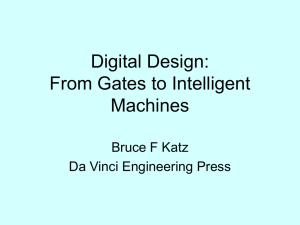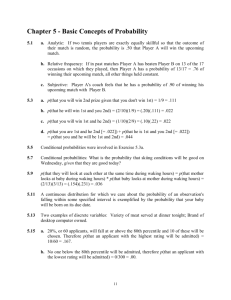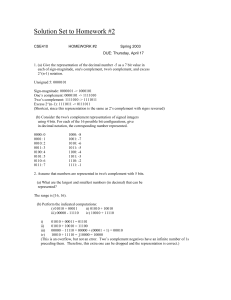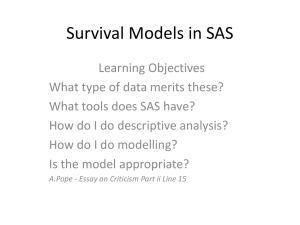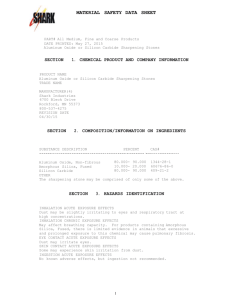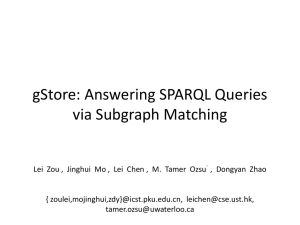Exam 4 - Pages - University of Wisconsin
advertisement
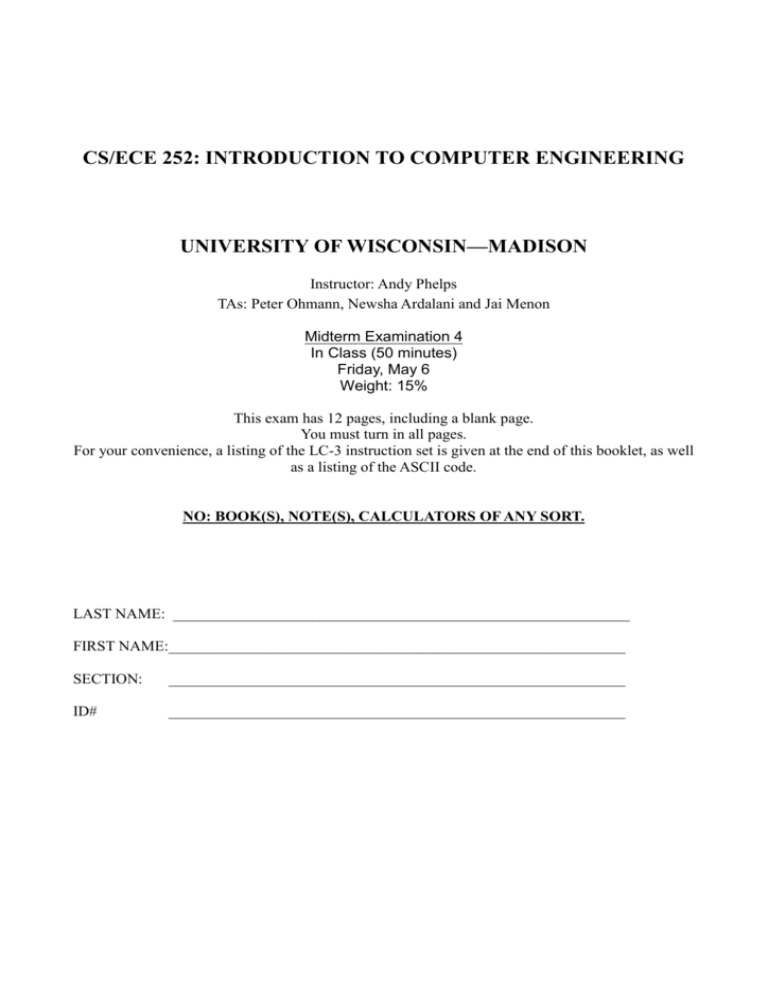
CS/ECE 252: INTRODUCTION TO COMPUTER ENGINEERING
UNIVERSITY OF WISCONSIN—MADISON
Instructor: Andy Phelps
TAs: Peter Ohmann, Newsha Ardalani and Jai Menon
Midterm Examination 4
In Class (50 minutes)
Friday, May 6
Weight: 15%
This exam has 12 pages, including a blank page.
You must turn in all pages.
For your convenience, a listing of the LC-3 instruction set is given at the end of this booklet, as well
as a listing of the ASCII code.
NO: BOOK(S), NOTE(S), CALCULATORS OF ANY SORT.
LAST NAME: ___________________________________________________________
FIRST NAME:___________________________________________________________
SECTION:
___________________________________________________________
ID#
___________________________________________________________
Question
1
2
3
4
5
Total
Maximum Points
4
7
7
7
10
35
Points
1. Assembly Errors (4 Points)
In the following template for an assembly program, circle any labels where the first pass of the
assembler would report an error (if any).
.ORIG x3000
Main
Loop
End
...
...
...
...
...
...
Add
...
...
Sum
...
...
...
...
Loop
And
...
...
Or
...
...
X10
...
...
.END
2. Two-Pass Assembly Process (7 points)
An assembly language LC-3 program is given below:
.ORIG
AND
AND
LD
LD
BRz
JSR
ADD
JSR
BR
ST
HALT
x3000
R2, R2, #0
R3, R3, #0
R0, M0
R4, M1
DONE
INCR3
R2, R2, R0
DECR4
LOOP
R2, ANSWER
INCR3
ADD
RET
R3, R3, #1
DECR4
ADD
RET
R4, R4, #-1
LOOP
DONE
; Storage area for variables below:
ANSWER
.BLKW
#4
M0
.FILL
x0007
M1
.FILL
x0010
.END
a) Fill in the symbol table created by the assembler on the first pass of the above program. (4
points)
Symbol Name
Address
Once the symbol table is created, the assembler then creates a binary version (.obj) of the program.
A portion is listed below. Three lines are missing the binary.
0101 0100 1010 0000 ;AND R2, R2, #0
0101 0110 1110 0000 ;AND R3, R3, #0
0010 0000 0001 0000 ;LD R0, M0
0010 0010 0001 0000 ;LD R4, M1
0000 0100 0000 0100 ;BRz DONE
____ ____ ____ ____ ;JSR INCR3
0001 0100 1000 0000 ;ADD R2, R2, R0
____ ____ ____ ____ ;JSR DECR4
0000 1111 1111 1011 ;BR LOOP
0011 0100 0000 0001 ;ST R2, RESULT
____ ____ ____ ____ ;HALT (TRAP x25)
0001 0110 1110 0001 ;ADD R3, R3, #1
1100 0001 1100 0000 ;RET
0001 1001 0011 1111;ADD R4, R4, #-1
1100 0001 1100 0000 ;RET
b) For each of the above missing lines, circle the correct binary value: (3 points)
Missing Line #1
1) 0100 1000 0000 0100
2) 0100 1000 0000 0101
3) 0100 1000 0000 1011
Missing Line #2
1) 0100 1000 0000 0100
2) 0100 1000 0000 0101
3) 0100 1000 0000 1101
Missing Line #3
1) 1111 0000 0010 0101
2) 1111 0000 0001 1001
3) 1111 0000 0000 1101
3. I/O in LC-3 (7 Points)
An LC-3 program is provided below:
AGAIN
ASCII
NEG
DSR
DDR
.ORIG x3000
LD
R0, ASCII
LD
R1, NEG
LDI
R2, DSR
BRzp AGAIN
STI
R0, DDR
ADD R0, R0, #1
ADD R3, R0, R1
BRn
AGAIN
HALT
.FILL
.FILL
.FILL
.FILL
.END
x0043
xFFB6
xFE04
xFE06
; Address of DSR
; Address of DDR
a)
What is the purpose of "STI R0, DDR"? (1 points)
b)
What is the purpose of reading the Display Status Register (DSR)? (2 point)
c)
What is in DSR bit 14, but we are not using in this program? (1 point)
d)
What does this program do? (3 point)
4. Subroutines (7 Points)
In the code below, the Subroutine ONECHAR takes 1 character from the user (keyboard) and saves
it into memory. The assembly code uses ONECHAR in a loop 6 times to input 6 characters and save
them to memory. Finally, it prints the string to the screen.
1
2
3
4
5
6
7
8
9
10
11
12
13
14
15
16
17
18
19
20
21
22
23
24
25
26
27
28
29
30
31
;CODE TO INPUT AND PRINT 6 CHARACTERS
.ORIG x3000
AND R0, R0, #0
; Initialize R0, our counter
LEA
ADD
ST
JSR
LD
ADD
LD
ADD
BRp
LEA
PUTS
HALT
R1, INPSTRING
R1, R1, R0
R0, SAVEREG1
ONECHAR
R0, SAVEREG1
R0, R0, #1
R1, LENGTH
R1, R1, R0
LOOP
R0, INPSTRING
; R1 now has base of INPSTRING
; R1 now has base + offset = R0
; SAVE R0
; Call Subroutine
; Restore R0
; Increment R0
; Load R1 with minus length
;
; loop till 6 characters are reached
; Get ready to print
; TRAP x22: Print string
; We're done
ST
GETC
STR
____, SAVEREG2
R0, R1, #0
; SAVE ?? upon entering the subroutine
; TRAP x20: Get a character from keyboard.
; Save keyboard input (R0 contains input)
LD
RET
____, SAVEREG2
; Restore ?? before leaving
.FILL
.FILL
.FILL
.FILL
.FILL
.BLKW
.END
0xFFFA
0xFE00
0xFE02
0x0
0x0
7
; minus Length (-6)
LOOP
ONECHAR
LENGTH
KBSR
KBDR
SAVEREG1
SAVEREG2
INPSTRING
(a)
Line 8 saves R0 before calling the subroutine ONECHAR. Briefly explain why this is
necessary. (2 points)
(b)
What other register needs to be stored and restored inside the subroutine? Fill in lines 19
and 22 above. (2 points)
(c)
In the program we save and restore registers two places, in lines 8 and 10 and again in lines
19 and 22. For lines 8 and 10, indicate whether it illustrates Caller-save or Callee-save. (1 point)
(d)
How many times will each character appear on the screen? Why? (2 point)
5. General Questions (10 points)
Circle the best answer.
I. A new service routine is defined starting in memory location x3700. After loading a program that
calls this subroutine, the user sets memory location x0067 to x3700. Which of the following can be
used to call this subroutine?
a. TRAP x3767
b. TRAP x67
c. TRAP x3700
d. TRAP x0037
II. JSR <label> is equivalent to
a. LEA R7, #0
[that is, 1110 111 000000000]
BRnzp <label>
b. LEA R7, #1
BRnzp <label>
c. LEA R7, <label>
JMP R7
d. All of the above are equivalent
III. JSRR R3 is equivalent to
a. LEA R3, #0
JMP R7
b. LEA R7, #1
JMP R3
c. LEA R3, #0
JMP R3
d. LEA R3, #1
JMP R7
IV. Into what phase of the control state machine is the logic to test for an interrupt signal usually
added?
a. just before Decode
b. just after Decode
c. just after Evaluate Address
d. just before Execute
e. just after Store Result
V. Which of the following can be used only once in the program?
a. .END
b. .HALT
c. .FILL
d. .BLKW
VI. Assembling the instruction ADD R1, R1, #45 causes which of the following errors?
a. Immediate value is out of range
b. ADD instruction takes only 3 register sources (2 sources + 1 destination)
c. R1 is not initialized
d. The instruction does not cause an error.
VII. How many memory locations are used by the following assembly directive?:
MYFAVORITE .STRINGZ "Exam 4"
a. 3
b. 4
c. 6
d. 7
e. 8
VIII. Which one of the following is correct about "Caller-save"? (circle the correct answer)
a) It is better than Callee-save, since the caller knows exactly which registers
the subroutine will overwrite.
b) It is used primarily in ISAs that have very wide registers.
c) It might end up saving registers that didn't really need to be saved.
d) It's particularly useful when entering interrupt handlers, to save the user's registers.
IX. Comments are:
a) Unimportant because they are only for people, not the assembler.
b) Useful, but only if someone else takes over working on your program.
c) So important that you should have a comment on every line, e.g.
ADD R0,R0,R1
; Adds R1 into R0
d) Important for the author, as well as for reviewers, maintainers, and users of the software.
X. If you execute a RET instruction in memory location x4231, what is the possible range of values
for the PC afterwards? [PCinc indicates PC after it is incremented.]
a. x0000 -- xFFFF
b. (PCinc - 2048) -- (PCinc + 2047)
c. (PCinc - 256) -- (PCinc + 255)
d. (PCinc - 16) -- (PCinc + 15)
Scratch Paper
ASCII Table
Char Dec Oct Hex | Char Dec Oct Hex | Char Dec Oct Hex | Char Dec Oct
Hex
------------------------------------------------------------------------------------(nul)
0 0000 0x00 | (sp)
32 0040 0x20 | @
64 0100 0x40 | `
96 0140 0x60
(soh)
1 0001 0x01 | !
33 0041 0x21 | A
65 0101 0x41 | a
97 0141 0x61
(stx)
2 0002 0x02 | "
34 0042 0x22 | B
66 0102 0x42 | b
98 0142 0x62
(etx)
3 0003 0x03 | #
35 0043 0x23 | C
67 0103 0x43 | c
99 0143 0x63
(eot)
4 0004 0x04 | $
36 0044 0x24 | D
68 0104 0x44 | d
100 0144 0x64
(enq)
5 0005 0x05 | %
37 0045 0x25 | E
69 0105 0x45 | e
101 0145 0x65
(ack)
6 0006 0x06 | &
38 0046 0x26 | F
70 0106 0x46 | f
102 0146 0x66
(bel)
7 0007 0x07 | '
39 0047 0x27 | G
71 0107 0x47 | g
103 0147 0x67
(bs)
8 0010 0x08 | (
40 0050 0x28 | H
72 0110 0x48 | h
104 0150 0x68
(ht)
9 0011 0x09 | )
41 0051 0x29 | I
73 0111 0x49 | i
105 0151 0x69
(nl)
10 0012 0x0a | *
42 0052 0x2a | J
74 0112 0x4a | j
106 0152 0x6a
(vt)
11 0013 0x0b | +
43 0053 0x2b | K
75 0113 0x4b | k
107 0153 0x6b
(np)
12 0014 0x0c | ,
44 0054 0x2c | L
76 0114 0x4c | l
108 0154 0x6c
(cr)
13 0015 0x0d | 45 0055 0x2d | M
77 0115 0x4d | m
109 0155 0x6d
(so)
14 0016 0x0e | .
46 0056 0x2e | N
78 0116 0x4e | n
110 0156 0x6e
(si)
15 0017 0x0f | /
47 0057 0x2f | O
79 0117 0x4f | o
111 0157 0x6f
(dle) 16 0020 0x10 | 0
48 0060 0x30 | P
80 0120 0x50 | p
112 0160 0x70
(dc1) 17 0021 0x11 | 1
49 0061 0x31 | Q
81 0121 0x51 | q
113 0161 0x71
(dc2) 18 0022 0x12 | 2
50 0062 0x32 | R
82 0122 0x52 | r
114 0162 0x72
(dc3) 19 0023 0x13 | 3
51 0063 0x33 | S
83 0123 0x53 | s
115 0163 0x73
(dc4) 20 0024 0x14 | 4
52 0064 0x34 | T
84 0124 0x54 | t
116 0164 0x74
(nak) 21 0025 0x15 | 5
53 0065 0x35 | U
85 0125 0x55 | u
117 0165 0x75
(syn) 22 0026 0x16 | 6
54 0066 0x36 | V
86 0126 0x56 | v
118 0166 0x76
(etb) 23 0027 0x17 | 7
55 0067 0x37 | W
87 0127 0x57 | w
119 0167 0x77
(can) 24 0030 0x18 | 8
56 0070 0x38 | X
88 0130 0x58 | x
120 0170 0x78
(em)
25 0031 0x19 | 9
57 0071 0x39 | Y
89 0131 0x59 | y
121 0171 0x79
(sub) 26 0032 0x1a | :
58 0072 0x3a | Z
90 0132 0x5a | z
122 0172 0x7a
(esc) 27 0033 0x1b | ;
59 0073 0x3b | [
91 0133 0x5b | {
123 0173 0x7b
(fs)
28 0034 0x1c | <
60 0074 0x3c | \
92 0134 0x5c | |
124 0174 0x7c
(gs)
29 0035 0x1d | =
61 0075 0x3d | ]
93 0135 0x5d | }
125 0175 0x7d
(rs)
30 0036 0x1e | >
62 0076 0x3e | ^
94 0136 0x5e | ~
126 0176 0x7e
(us)
31 0037 0x1f | ?
63 0077 0x3f | _
95 0137 0x5f | (del) 127 0177 0x7f



